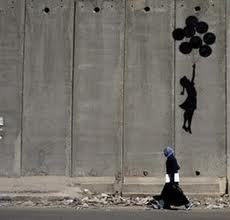A Presbyterian Reflection on Mission, Beauty, Truth, and Banksy
I grew up in the mainly drab evangelical Bible Church/Southern Baptist religious confines of functionality and perhaps a sewn banner with a Bible verse on it. The visual and art were of little consequential value, perhaps only found in the dying faith and idolatry of ornate Catholicism. It was in college when I began to attend a Presbyterian church that I was almost scandalized by the beauty of the architecture of a near hundred year old building with soaring spires, colorful stained glass, and a golden cross that was marched down the aisle before and after each service. Had I joined a Catholic church?
But, this church was not some newcomer to the visual show, attempting to piggy back onto the culture of the postmodern shift to images, as so many others. No these were Presbyterians, proudly tracing their heritage back to Calvin and Knox. A church of city elites it had a long history of support for the arts and also missions. It hosts a continual art gallery on its campus (with rotating exhibits) to show the intersection of faith and beauty. It has also sent out hundreds of missionaries all over the world, and was the financial seed bed for the Jesus Film. There I have become friends with sculptors, actors, directors, and painters, and faith defying missionaries.
Our pastor Dr. Rev. Ron Scates, who recently retired from the pulpit, in his closing sermon challenged the congregation to make the gospel known through a commitment to embodying truth and beauty in all that we do, and whatever God has called us to do… whether a banker, a race car driver, or a painter. Mission and art are not mutually exclusive, perhaps they are vitally intertwined.
William Dyrness in Visual Faith: Art, Theology, and Worship in Dialogue had me thinking of the intersection of mission and visual art, that I believe my Presbyterian church understands better than most. Dyrness laments the separation of word from visual meaning that occurred in the Reformation and prefaced the modernist turn. If anything, it seems the elevation of word over visual was perfected by the American evangelical boom into hundreds of denominations all trying to be something newer and less like their predecessors. American evangelicalism is functionally still very modernist, although it certainly struggled grasping modern art, and it is only now with the postmodern turn and a cultural fascination with surface, image, and video that the church is attempting to play catch up. Although, it still feels to me that the American church’s new appropriation of the visual is often without reflection or deeper critique. It has almost become trite that every sermon will be accompanied by a movie clip. Perhaps the mainline denominations have done a better job, having partially kept a finger in that Catholic mentality, and often being populated by cultural and intellectual elites. Although the non-evangelical mainline have seen the ignoring of mission lead to its growing decline, another harbinger of the importance of art and mission as connected. I also wonder how evangelical engagement with the arts differs from culture to culture, here I am thinking of my adopted culture (Spain) where beauty and art are everywhere and in everything.
Are Christians engaging with the arts? Are they dealing with the big questions that art is dealing with today? One of the fastest growing areas of the visual arts pertains to street art. What was once mere graffiti (the tags of gangs or maladjusted teens) is now the provenance of avant garde artists questions the status quo, making political statements, making statements about artistic intent, permanence, consumerism, legality and creating beauty and truth amongst urban landscapes. Street evangelists. One of the most famous street artists is Banksy (his true identity is still in question) has become something of a prankish conceptual artist, whose work is highly sought after. Pastor Sandy did a good write up on him from last semester here: http://blogs.georgefox.edu/dminlgp/post/59050013092/street-art
Banksy is known for street art that makes a strong political and social statement, while often being quite playful or biting. His work even occurred on the West Bank wall dividing Israel from the Palestinians. The simple and beautiful image of a girl gliding up the wall to freedom is evocative. But, if Bansky’s work is political, it is also controversial as it poses the question along with Dyrness of the divide between high art and low (or pop) art. Can something painted on the underpass of a bridge be art? Can something that is not permanent and essentially appropriates other artist’s work be art? Can something illegal be art? Can an anonymous street artist who sells his “illegal” works for millions of dollars truly be an authentic artist?

In the postmodern shift of art in the 20th century, Christians must be ready to enter into these questions of the visual? These are the questions (or at least the de facto understandings) of much of our world… beauty and truth, or who has it, and what is it? In one sense, these are waters of opportunity, new ways of expressing and connecting truth and beauty, and certainly our postmodern world is looking for truth, but also the expression of that truth in a visual form. Rev. Scates explained that “beauty without truth is fantasy, truth without beauty is dead orthodoxy.” The world is screaming for the combination but so often finds itself only caught up in the emptiness of fantasy, or the choking dust of dead orthodoxy. Christianity stands as the best hope of merging the two, and understanding how through common grace even a renegade like Banksy can communicate God’s truth and beauty. These are not easy waters, and churches and Christians are needed who can legitimately reflect and create art that is not tacky, trite, or utilitarian like so much evangelical bric-a-brac. I think of my friend Jesus Orsorio who carries a Ph.D in fine art and does week long projects with actors, artists, and videographers on the streets of Europe. Through a series of visual performances humanity’s state of broken relationship is communicated. Also, I recall my friend NiKo, who lives in a missional community of other Christian artists in Madrid, making his own street art. An integration of art and mission.

Banksy also has made a film called Exit Through the Gift Shop. http://www.youtube.com/watch?v=oHJBdDSTbLw It tells the unlikely tale of the burgeoning street art movement and a French man named Thierry becomes the obsessive videographer of the movement, making friends with such famed artists as Shepherd Fairy and Banksy. The documentary starts off as love letter to street art and what it can do, and its growing popularity and acceptance. However, half way through the documentary takes a strange and ultimately comically poignant turn. Banksy under the guise or wresting the film archives away from Thierry sends him back off to California to produce his own street art. Rapidly Thierry transforms himself into Mr. Brainwash splattering his visual images across LA, preparing for his own massive showing, hiring artists to create his almost comical and trite conceptual images into reality. Through his efforts at larger than life circus hype, and the reluctant endorsements of Fairy and Banksy, Mr. Brainwash pulls off a massive financial coup selling millions of dollars of prints of his supposed work, much of it looking like knock offs of Banksy and Andy Warhol. Moreover, the scheduled show, originally meant to run for a few days, stays open for a couple of months.
Of course, the joke is on us. Thierry by his own admission (post documentary) explains that he is Banksy’s greatest creation. A living conceptual piece of art. It seems no one picked up on the name Mr. Brainwash, and that this was just an elaborate prank by Banksy… continuting to push the boundaries, but also asking important question of artistic agency and value. Moreover, he delves into the consumption and consumerism of art. Banksy has shown that hype and perceived value create the consumer market for much of art. For an anonymous street artist he has made an essential point, neither monetary value, nor critical whim can place a value on beauty and truth. True art can be anywhere, even on the side of a wall, or it can be nowhere, even in a gallery selling for millions of dollars. Postmodernity once again shatters the categories that we want to maintain. A democratization of art, the visual in everything, but the question of beauty and truth versus fantasy and dead orthodoxy still is the question all are grasping for. It is into this space that Christians can step into in mission, and ask and answer these very same questions hopefully pointing many to truth.
But, here is the rub. We must avoid from seeing art as a strategy. It must be holistic and a natural extension of who we are, any artist will agree. On the flip side, mission must not be a strategy (although most certainly most Christians see it as such). No mission, like art, must be a natural ontology of who we are as Christians, the communication of beauty and truth to transform lives.
Leave a Reply
You must be logged in to post a comment.